
One of the appealing things about collecting cameras is discovering the huge variety of brands, styles, and variants that have existed over the past 100+ years. No matter what size negative you wish to shoot, whether you want something fully automatic or completely manual, if you’re left or right handed, there’s something for you.
With the immense variety in cameras, there is also a lot of variation in the names of cameras. Some of them incorporate a function of the camera into the model name, sometimes there’s a sequence of numbers and letters that indicate a series, and sometimes the names are just random words or numbers that mean nothing at all.
But sometimes, the names of cameras can be quite…unfortunate. Maybe the name of the camera originally meant nothing when it was first created, but over time the name evolved into a vulgar or strange slang term, sometimes there’s a language or cultural reason why a name might seem strange, and sometimes, well, the name was probably strange to begin with.
I thought it would be fun to look at some of the more unfortunately named cameras that I’ve come across. I don’t have most of these in my collection, so don’t expect full reviews for most of these, they’re just for fun.
In 1965, Polaroid introduced a new line of inexpensive instant cameras called the “Swinger”. The first model was the Swinger Model 20, and it sold for the low price of $19.95. Shortly after it’s release, it became Polaroid’s best selling model, featuring extremely simple controls and some type of extinction meter that would show the word “YES” in the viewfinder when you had enough light to make an exposure. The camera used Polaroid’s 20-series roll film which was the company’s first film that developed outside of the camera.
The Swinger was so popular that it launched several variants, the Swinger II, the Super Swinger, and my favorite, the Big Swinger 3000 which was for those swingers where size matters!
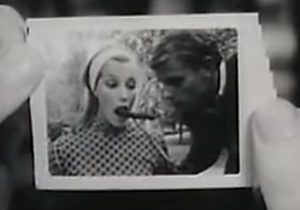
Whether intentional or not, the term “swinger” has a very perverted connotation that I have a feeling Polaroid was very aware of when releasing this camera. A famous 1965 commercial for the Swinger features a very catchy Barry Manilow song called “Meet the Swinger” and a variety of VERY happy young people doing young people things like….wait a minute, what is that in her mouth?
In his book, “How Sex Got Screwed Up: The Ghosts that Haunt Our Sexual Pleasure”, author Jon Knowles credits adult book stores, the video cassette recorder, and Polaroid’s instant cameras like the Swinger for the rise of home-made porn.
I don’t think there is any way all the sexual references in the name and advertising was on accident or if Polaroid really thought they could pull the wool over our eyes, but I suspect at least a few “swingers” shot some interesting photos with a Swinger!
If Austin Powers was a real person, I am quite certain he would have owned a Swinger too! Yeeeaaahhh baby!
This next one’s a bit more innocent and an example of how seeming randomly sequences of letters can one day mean something completely different. The Olympus OM-G was part of Olympus’s very successful OM-series of 35mm SLR cameras. The OM-G was a mid level model when it was released in 1983.
The OM-G was only sold in the Untied States as it was called the OM-20 in other markets. The model was an upgrade from the previous OM-10 by adding a better way of selecting shutter speeds without an adapter, a bright viewfinder with mode display, and an improved winding mechanism that supported speeds as fast as 5 frames per second when attached to the available motor drive.

The letters OMG didn’t mean much for the first decade or two after the camera’s release, but then the Internet happened and everything got abbreviated and OMG became the calling card of Sir Mix-A-Lot and Janice from Friends.
Nowadays, OMG along with other abbreviations like LOL, YMMV, and IRL are commonplace in text messages, social media, and even sometimes in spoken language.
Interestingly, at the same time Olympus released the OM-G, they also released the OM-F, which was called the OM-30 outside of the US. The OM-F had an early form of auto focus that worked with only one lens. The camera wasn’t very successful and is very hard to find today.
While not as unfortunate of a name as OM-G, imagine if Olympus had combined the two models to make the OMFG!
This next camera has not only an unfortunate name, but an unfortunate design, and frankly, an unfortunate existence.
Released in 1967, the Argus Lady Carefree was an inexpensive Instamatic camera that was built in Germany by Balda for Argus. It was a simple camera with no manual controls and only supported the use of a rotating flashcube and nothing else. It was identical in function and design to the Argus Carefree 164 camera, which must have been the man’s model.
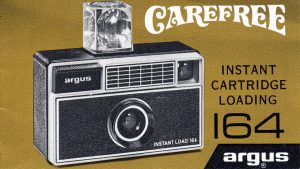
A second Lady Carefree was also produced, but was made by Sedic in Japan with a different, but equally atrocious design.
Built in the “Mad Men” era when women were frequently gaslighted and not expected to be able to handle the advanced features of “a man’s camera”, the Lady Carefree has a white plastic body with gold foil markings, and what looks to be some kind of paisley front design that maybe suggested a lady’s hand bag.
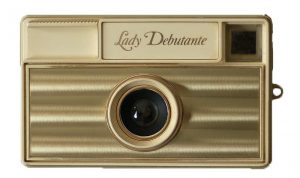
A similar camera with a different front design called the Lady Carefree Elite and a non Argus branded Lady Carefree Debutante rounded out the series, but seem to have the exact same features as the original model.
A product like this couldn’t possibly exist today, but don’t hate on Argus too much as developing scaled down cameras specifically designed for women was something big companies like Nikon did as well. In 1979, Nikon would release the Nikon EM SLR which had a smaller size and simpler interface, said to be easier for women to use. Interestingly, Nikon’s 2020 website still references the EM as the SLR for Women.
Voigtländer Vag
Since we’re on the topic of women, how about a camera called the Vag?
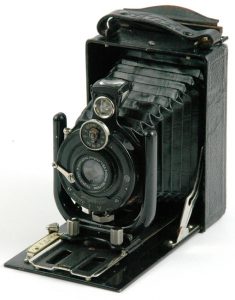 What’s that short for? Vagabond? Vagrant? Vague? Vagina? Who knows!
What’s that short for? Vagabond? Vagrant? Vague? Vagina? Who knows!
The Voigtländer Vag was a series of entry level folding plate cameras sold between 1925 and 1935 featuring genuine leather coated aluminum bodies, a rising and falling lens standard, and came with several combinations of good quality Voigtländer lenses and German shutters.

Central Camera’s 1932 catalog lists the prices of the Vag starting at $16 for the 6.5cm x 9cm model with Voigtar 6.3 lens and Embezet shutter to $29 for the 9cm x 12cm model with Skopar 4.5 lens and Ibsor shutter. These prices when adjusted for inflation, compare to $300 and $550 today making them an affordable option for the amateur.
Voigtländer cameras of the same era had cool sounding names like Avus, Bergheil, and Jubilar, so why the name Vag was chosen is anyone’s guess. Maybe it was actually an acronym for Voigtländer’s Amazing Gear. Maybe it was short for someone’s name.
In this list of unfortunate names, we probably should give Voigtländer some slack as it’s highly likely that 95 years ago when this camera was first sold, that the name probably meant something completely different. Still, I would definitely recommend against asking any camera collectors if you can play with their Vag.
Moving onto another bodily orifice, we have the Rectaflex. The Rectaflex was an innovative 35mm SLR built in Rome, Italy starting in 1948. Designed by a Roman lawyer named Telemaco Corsi, it was the very first 35mm SLR to feature a pentaprism viewfinder, narrowly beating out the Zeiss-Ikon Contax S as the first camera to have that feature.
Other features of the Rectaflex were an in body film cutter like the one on the Ihagee Exakta, a focal plane shutter with speeds up to 1/1000, and an interchangeable bayonet lens mount. A later variant had a revised shutter with a top speed of 1/1300.
Amazingly, there was another camera with the name Rectaflex, but it was an inexpensive Japanese TLR that is thought to be an export only variant of the Kigawa Kōgaku Tubasaflex. I’ve never seen a picture of this camera however.
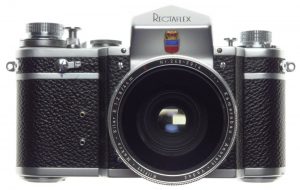
Telemaco Corsi must have really been attached to giving names to things starting with “Recta”, that in 1953 he created a 35mm rangefinder variant called the Recta, of which six are known to exist. I wonder if an all manual variant of the camera might have existed called the Recta M.
The Italian Rectaflex was very expensive and produced in small quantities meaning that not many were sold. After struggling in an increasingly competitive marketplace, the company that made them went bankrupt in 1955. The brand was briefly revived by the Prince of Liechtenstein and a slightly revised model, unofficially called the Rectaflex Liechtenstein was produced for a very short time.
We’ve talked about butts once already in this article, so I guess it’s fitting to have more rectum themed jokes. Here’s a good one:
A man walks up to a proctologist and asks if he can borrow a pencil. The doctor says sure, and reaches into his pocket and pulls out a thermometer and says “Damn, some asshole has my pencil.”
Google Translate says the Italian translation for rectum is “Retto” so maybe the camera could have been called the Rettoflex and frankly us English speaking types would be none the wiser. Perhaps Telemaco Corsi could have named the camera after himself and called it the Corsiflex. Maybe it would have sold better as I have to imagine pointing a Rectaflex at someone and asking them to smile, often caused them to break out in laughter. I mean, I know I would.
In 1972, Kodak would release an all new miniature film format based on unperforated 16mm film called Pocket Instamatic or Type 110 film. Photographs shot on 110 film have an exposure size of 13mm x 17mm or roughly one quarter the size of regular 35mm.
The earliest 110 cameras were very basic models featuring fully automatic operation, slow lenses, and not much else.
In 1975, Canon would eschew the idea that Pocket Instamatic film was only for cheap cameras and release a very sophisticated model called the Canon 110ED with a fast 5-element 26mm f/2 lens, a coincident image rangefinder, aperture priority automatic exposure with speeds from 8 seconds to 1/500, and a date imprint feature.
 Breaking down the model name, 110 was the type of film the camera used, E probably meant electronic, and D meant ‘date’ as there was also a Canon 110E version without the date imprint feature. The thing is, for nearly 50% of men age 50 or older ED, or Erectile Dysfunction is a frustrating, and sometimes embarrassing disorder.
Breaking down the model name, 110 was the type of film the camera used, E probably meant electronic, and D meant ‘date’ as there was also a Canon 110E version without the date imprint feature. The thing is, for nearly 50% of men age 50 or older ED, or Erectile Dysfunction is a frustrating, and sometimes embarrassing disorder.
Although ED by itself isn’t dangerous, it could be a symptom of much more severe medial issues such as diabetes, heart disease, hypertension, prostate cancer, and obesity. If you are experiencing the systems of ED, consult a urologist immediately!
Our understanding of ED is better today than it was in 1975, but there’s nothing to indicate this is a recent problem, so I am sure just as many men were affected by it when this camera was first released, and I wonder if seeing the letters “ED” in a camera name touched a nerve for someone.
Since we’re talking about medical disorders, the Canon 110ED wasn’t the only camera to have a name in common with one. In the late 1950s Minolta had a lineup of low to medium end 35mm rangefinder cameras called the Minolta A-series. Featuring fixed lenses with a leaf shutter and a coincident image coupled rangefinder, the cameras sold well and were very popular.
The series continued through to the A 5 which was released in 1960 and came with a top 1/1000 shutter speed and an available Rokkor-PF 45mm f/2 lens. In 1961, the A 5 was updated to include a selenium exposure meter, and the model name was changed to the Minolta AL. The AL continued to be successful for Minolta, so they kept updating the model. First came the AL-2 in 1963, and then in 1966, the Minolta ALS. The ALS was the first A-series camera with a CdS exposure meter, and also featured a new Rokkor-QF 40mm f/1.8 lens making it quite a capable camera.
There’s a bit of irony in giving the name ALS to a highly capable camera because another form of ALS, which stands for Amyotrophic Lateral Sclerosis, or more commonly Lou Gehrig’s Disease, is a completely debilitating disease which weakens the muscles of the patient, resulting in loss of functions such as the ability to walk, use their hands, speak, swallow, and breathe.

The New York Yankees superstar Lou Gehrig famously suffered from the disease which heightened awareness of it and gave it the nickname “Lou Gehrig’s Disease” but more recently, physicist Stephen Hawking’s case was much more visible for a newer generation.
Minolta loved the letters ALS so much that they actually used it on two separate, but closely related cameras, the other of which was the Minoltina AL-S, a smaller and more compact camera with the same lens as the Minolta ALS, but with a selenium exposure meter.

I doubt anyone at Minolta meant any disrespect when they chose the name ALS for both of these cameras, but the disease was well known back them so I have to wonder why they couldn’t have chosen something else, like maybe the A6!
Since I’m picking on Minolta’s AL-series, there’s one more model that I’d like to point out, although this one’s a bit more light-hearted, which is the lower end Minolta AL-F from 1967. Sharing a namesake with a certain lovable furry alien with an appetite for cats, Gordon Shumway would have been a fan of the AL-F!
Yep. There was once a camera called the FAG. At least it’s an acronym though.
Most people are aware that in the former Soviet Union, copies of the Leica II rangefinder were made as both the FED and Zorki. But what you might not know is that those weren’t the only two. In fact, there were four different Leica II copies. The VOOMP II Pioneer was a Leica II copy produced between 1933 and 1937 by the Union of Optico-Mechanical Companies or VOOMP. An estimated 1600 VOOMP II Pioneers were ever made, making them quite rare.
But the other was an even rarer model, produced by Moscow Zavod called the Foto Apparat Geodeziya, or FAG for short. The FAG appears to have only been made in 1933 and 1934, and an unknown number were made.
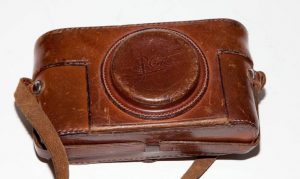
Both the VOOMP II Pioneer and FAG closely resemble the Leica II with the most obvious exception that they both lack an accessory shoe on the camera’s top plate. The FAG differs from the Pioneer in that it’s lens is fixed and cannot be removed. There were at least three variations of the camera, one with a Leica I style hockey stick shaped infinity stop, one without the infinity stop, and a third that had no lens at all, instead featuring a black metal tube which was thought to be used for scientific purposes.
I’m sure I don’t need to explain the unfortunateness of the camera’s name with a slang term for cigarettes in Britain, and that other thing. It’s an acronym of a Russian name, and it’s an incredibly rare camera that most people are unlikely to ever see.
In 1954, the German manufacturer Eugen Ising produced a compact 6×6 roll film camera called the Isis. The Isis was a pretty basic camera with a collapsible Prontor shutter and one of two 75mm f/3.5 lenses.
Their choice of the name “Isis” was likely a shortening of the name “Ising” of which the company was named after, but it could have also been chosen as it was the name of an ancient Egyptian goddess first mentioned between (c. 2686–2181 BCE).

Whatever Ising’s reason for the name, little would they know that decades later, one of the world’s largest terrorist organizations would go by the same name. Sure, ISIS was an abbreviation, but in recent times, mention the word “Isis” to anyone and they’re definitely not going to think of an obscure camera from the 1950s.
Ising wasn’t alone in choosing the name Isis for their product as the name has been used quite a number of other times on everything from a Verizon Wireless backed mobile payment service, to a Boston based heavy metal band, multiple comic book characters, and even an early Intel based computer operating system.
Thank goodness there was never a camera named the Al-Qaeda.
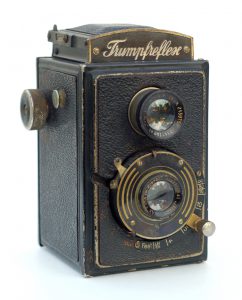
Trumpfreflex
Speaking of terrorists, in what could possibly be the most unfortunately named camera ever, we have the Trumpfreflex. Sure, it’s got an extra “F” in there, but anything beginning with the letters “T”, “R”, “U”, “M”, and “P” evoke nightmarish visions of one of the world’s most dangerous men.
In 1933, the German company Kamera-Werk C. Richter Tharandt, or Richter for short, produced an unassuming simple twin lens reflex camera called the Reflecta. The camera was meant to be a low cost alternative to more expensive German 6×6 TLRs made by Franke & Heidecke and Zeiss-Ikon.
Featuring a basic shutter and lens combination in a mostly steel body and not much else, the Reflecta was very affordable and sold well throughout the 1930s.
Perhaps in an effort to increase sales by distributing their cameras out west, around 1939, Richter agreed to a deal with the Sears, Roebuck, & Company to sell the camera in the United States under the name “Trumpfreflex”. The Trumpfreflex was identical to the Reflecta even down to the typeface on the camera’s name plate being similar to the original Reflecta logo. The only other difference was that the distance scale on the lens was in feet, instead of meters.
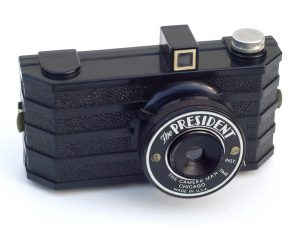
According to etymonline.com, the word “trump” can be traced as far back as the 16th century, when it was used to describe a high ranking hand in a game of cards. The word is thought to be an alteration of the word “triumph” and continued to be used as both a noun and a verb until the 1940s when a New York state real estate developer named Frederick Trump fathered a certain orange menace, forever changing the perception and meaning to the word “Trump”.
Sears has always had a long history of rebranding cameras made by other companies, so their desire to sell the Reflecta in their catalog is not strange, but why they chose the name “Trumpfreflex” is anyone’s guess. Perhaps they learned from their mistake as by the 1950s, most Sears branded cameras were sold under the brand pseudonym, “Tower”.
If I was an executive at Sears around the time this name was thought up, I might have offered them a much better alternate name, The President. Oh, wait a minute, someone did.
You knew it had to be here, and here it is. I started on this article in January 2020 with the idea of coming up with 10 cameras for a nice round number. I would add a camera as I thought of it and type a paragraph or two, save the draft, then come back when I had another. When I finally added the 10th camera, I figured I was done.
But here I am, sitting at home, quarantined like nearly the rest of the world from COV-19 and I guess this list of unfortunately named cameras wouldn’t be complete without a Corona camera.
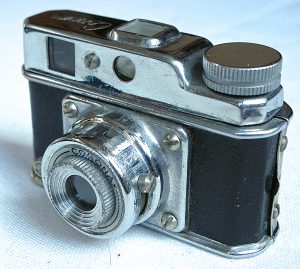
Corona cameras were subminiature “Hit-type” cameras that all used 17.5mm paper backed roll film. These were cheap cameras often sold as toys or given away as promotional items. The sheer number and variety of these types of cameras is immense, and there are those who specifically collect these.
As far as I can tell, there are two Corona cameras, the first design with a single viewfinder has a three speed shutter which is uncommon for Hit style cameras, but the second has two viewfinders, one for eye level and one for chest-level, and a single shutter speed.
Although finding these cameras today is pretty easy, getting film for them is not. Even if you do, developing them is a challenge as there’s no easy way to spool 17.5mm film to get it developed.
I wish Corona was just the name of an obscure Japanese camera and an excellent Mexican beer, but sadly, it no longer is…
Bonus: Stupid Bird Names
For an added bonus, while researching unfortunately named cameras, I realized how many were named after birds. And not even cool birds like hawks and ravens, but stupid birds like the pigeon and penguin.
The gallery below shows the Yashima Seiki Pigeonflex, Kershaw Eight-20 King Penguin, Taron Robin, Canon Sure Shot Owl, and Seagull Reflex DF.
I mean, I guess if you’re a bird person, calling any bird stupid is likely to ruffle some feathers, and admittedly, owls can sometimes be pretty helpful, especially when trying to figure out how many licks it takes to get to the Tootsie Roll™ center of a Tootsie Pop™, but damn, a Pigeon? At least no one used the name ‘titmouse‘.
 Thankfully Yashima got their act together and changed their name to Yashica and came out with some pretty terrific TLRs, Kershaw didn’t survive past the 1940s, and well, Seagull I think might still exist.
Thankfully Yashima got their act together and changed their name to Yashica and came out with some pretty terrific TLRs, Kershaw didn’t survive past the 1940s, and well, Seagull I think might still exist.
Still, I have to wonder why birds? And why those names? If I were a camera manufacturer trying to think of a cool name for my new camera, and someone suggested a bird’s name, I would probably want a name that in some way has some link to a camera.
Eagles are known to have excellent vision, so maybe calling my camera the “Eagleflex” might give the connotation that this camera has a very sharp lens that can see well.
Falcons are one of the world’s fastest animals, and while diving can achieve speeds as high as 240 mph, so perhaps “Falcon” could have been a great name for a fully automatic SLR from the 1970s to suggest the camera’s fast speed.
Heck, if I just wanted a cool name, perhaps “Velociraptor” would have worked, since I learned from watching Jurassic Park that they’re related to birds, and you know, they’re fast, smart, and awesome!
So that’s my list of ten eleven unfortunately named cameras. What do you think?
Let me know in the comments below if there’s any you think I missed!

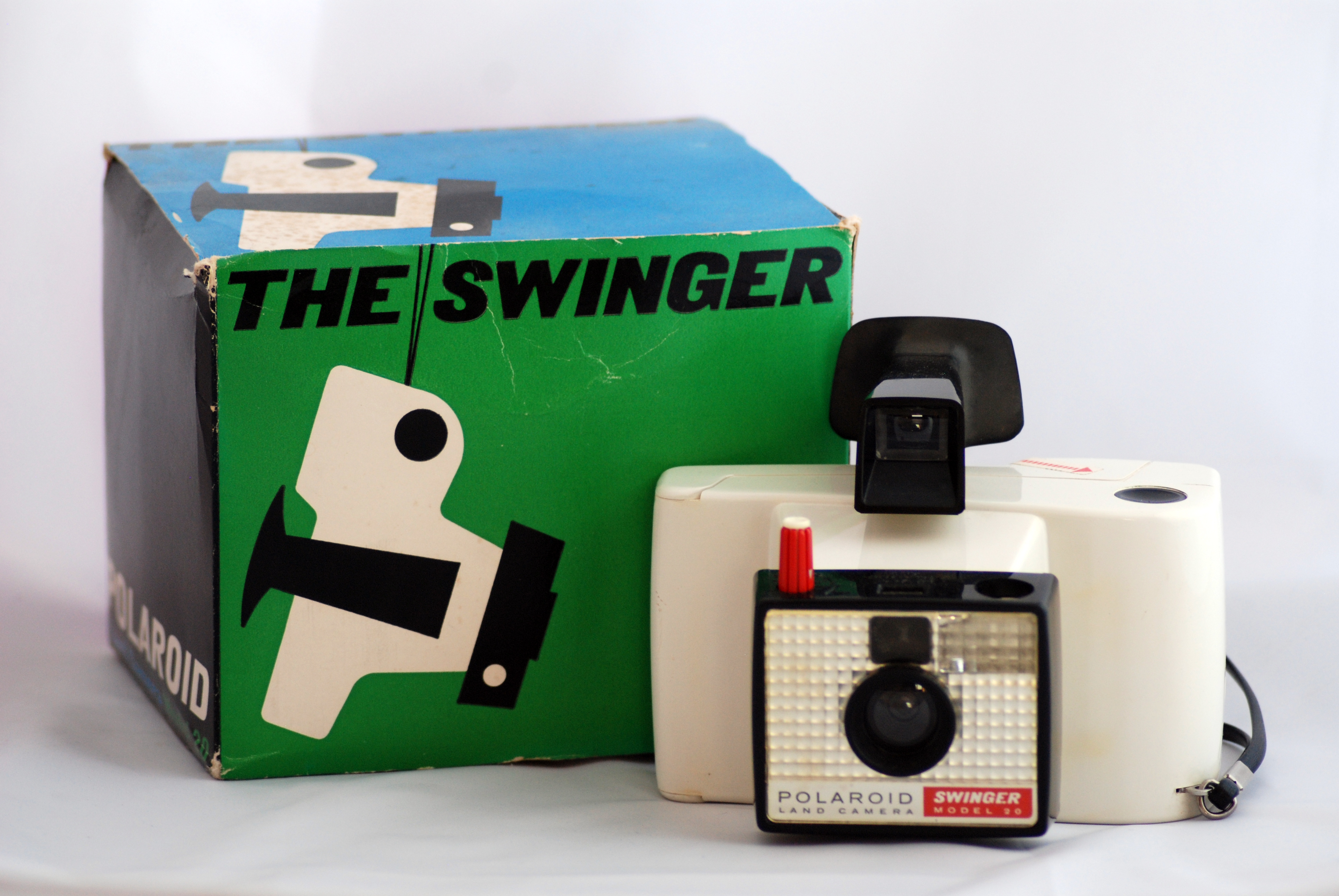
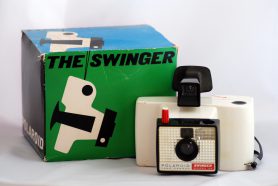
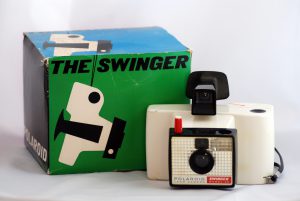
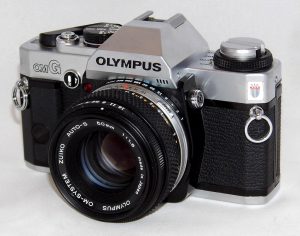
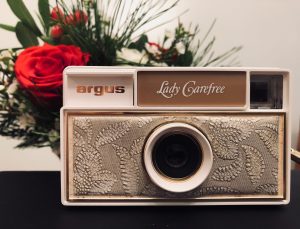

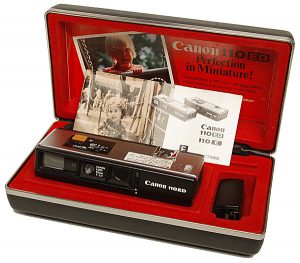
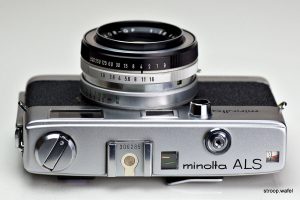

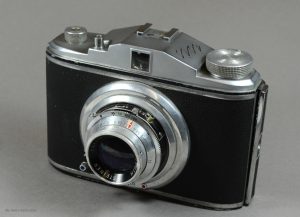
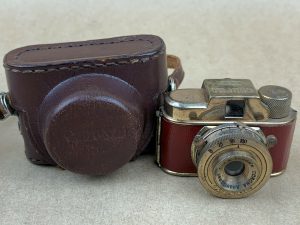






Mike, What a twisted mind you have. I’d never have made some of the connections.
I’d like to volunteer a camera. It’s not a regular camera as one would assume a camera to be. I’m talking about an oscilloscope camera made by an English electronics company and of which I have a one. The company name is Nacard, and is how I feel at the end of a long day.
I’ll send you a pic.
Great one. Gave me some good laughs with my morning coffee!
Glad you enjoyed it! I thought a humorous post was appropriate given the current state of the world.
I bought a Droog partly for the name.
Yes, that’s a good one. I’m getting a lot of suggestions for a future “Unfortunately Named Cameras Part 2”!
I have number of the postwar Japanese TLRs, Honestflex, Beautyflex, etc. Soon I’ll post pictures of the Doris, a pretty nice 50’s folder
Mike, what about any camera with Pro- in its name?
I kind of want to track down a Pigeonflex…
OK, it’s not “March Madness” at all, but “Cabin Fever” or Victorian “March Hare Madness.”;) I have come across camera names as varied as the examples above, chuckled/shrugged, then moved on.
I owned a Canon 110ED, until my older sister borrowed it and “forgot” it in the wilds of Hawaii island. (It wasn’t a primary camera, but the biggest thing was the way she blew it off as if it was a cheap Pocket Instamatic that she’d lost.)
The Rectaflex is a rare bird, indeed, and a “Unicorn” among camera collectors. Your humorous riff on it may bring prices down enough for you to add it to your GAS collection some day.;)
If you’re going to point at “Seagull” cameras, don’t forget that “Seagull film” was also a thing back them, too.;)
This is pretty funny stuff here, Mike – a good alternative to the slow steady thump of the drums of doom coming out of my radio. BTW, the Neoca Robin is a decent camera. I’ve got one and enjoy its bright, nearly fullsize view/rangefinder. Mine has a 45mm f2.8 Neocor lens, but there’s also a very rare version with f2.8 Zunow glass – clearly identified on the front of the lens. If you can find one of those, expect to part with $500 or so.
Entertaining post, Mike! I think the Wenk Wenka is also worth mentioning, although perhaps more of a British thing. The slang that is 😉 I thought the Felica Klimax is also entertaining. What’s in a name!?
Thanks for the suggestions, CJ! Including yours, I’ve received enough ideas for an Unfortunately Named Cameras part Two! 🙂
Those are actually the funniest 😀
Rectaflex mad eme laugh the loudest.
Even before 2016, “Trumpfreflex” was a ridiculous name! I can’t help but think that the original author got ‘reflex’ wrong, and called it ‘freflex’. Guess he could’ve called it ‘covfefe’ too XD
Speaking of birds, though, Zeiss should take the crown – Loxia and Otus are as dumb as they come. Batis is cool, though. You forgot the Soviet “Chaika” (seagull). I think Penguin and Robin are nice, cute names, but “Pigeonflex”!? Seriously? XD
Great blog entry, Mike! One of the best and funniest I’ve read. And with apologies in advance to your female readers, I’ll say I’ve got a nice Rak. A 1932 Welta Rak, that is. Looks like a shrunken Speed Graphic that was left out in the rain and then put in the dryer. I have no idea what the model name means. (I’ve got a nice picture of it sitting on the palm of my hand if you want it.) They made a similar camera called a Watson; at least that’s a real name. By the way, I may have an explanation for your Voigtländer Vag. The names of many German companies end in “AG” because that’s the abbreviation for “Aktiengesellschaft,” the German word for “corporation.” So Vag or VAG could simply be the abbreviation for “Voigtländer Corporation.” Not very exciting, though. And if my own name seems familiar, I bought a Voigtländer Superb from you several years ago. I now manufacture lens caps for them.
Glad you liked it Bryan! I am actually working on a Part 2 and hope to have it done before the end of the year! Hopefully you’ve gotten along nicely with the Superb. If you ever want to sell it back, let me know! 🙂
Interesting article until the writer Eckman stuck his foot in his mouth and made it political with his comment about the “Trumpfreflex. Sure, it’s got an extra “F” in there, but anything beginning with the letters “T”, “R”, “U”, “M”, and “P” evoke nightmarish visions of one of the world’s most dangerous men.” You lost all credibility with such a stupid comment!
I am sorry you didn’t like my article. I will try to do better with the next one! 🙂